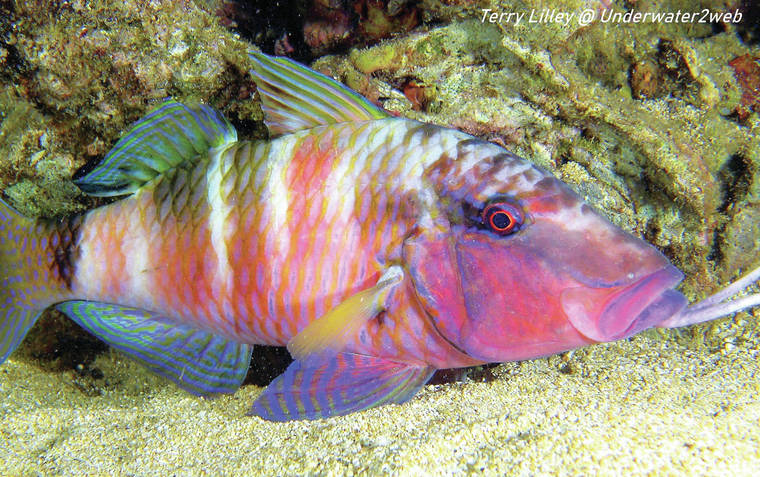This beautiful, foot-long goat-fish has many different colors, and changes color depending on whether it is in a cave or out in the direct sunlight. Often divers think it is two different kinds of goat-fish. When moano is feeding out on the sandy sea floor it turns a drab gry color with white bands, but as soon as it moves into a cave it turns bright purple, red and white. They are their most beautiful colors when they sleep at night on the sea floor, as they are quite stunning to look at up close in the bright dive lights.
This beautiful, foot-long goat-fish has many different colors, and changes color depending on whether it is in a cave or out in the direct sunlight. Often divers think it is two different kinds of goat-fish. When moano is feeding out on the sandy sea floor it turns a drab gry color with white bands, but as soon as it moves into a cave it turns bright purple, red and white. They are their most beautiful colors when they sleep at night on the sea floor, as they are quite stunning to look at up close in the bright dive lights.
Moano has two barbels under its chin, and these soft, whisker-like appendages can detect small shrimp and crabs that live under the sand or are hiding in small cracks in the reef. They use the barbels like little arms to flush out their prey and gobble it down quickly. The manybar goat-fish is such a good hunter that many other fish species follow it around and wait until the goat-fish scares up a hidden crab, then they try to steal the meal before moano can grab it.
People often confuse the name “moano” with the movie named “Moana.” “Moana” means “the deep blue sea,” but the fish moano is named for the red blossoms of the ‘ohi‘a lehua tree. In old times the Hawaiians thought the fish ate those blossoms to get their red colors.
The wonderful thing about the Hawaiian language is the marine creatures are usually named for a similar plant or animal living on land or something that describes their behavior. Just by knowing the Hawaiian name of the fish and what it means, you will learn something about the fish.
We do not see as many moano out on the reef as we did 50 years ago. This is due to the fact that the state imported the blue striped snapper (ta‘ape) into Hawaiian waters from Tahiti in 1956, and their populations exploded. Now the ta‘ape are one of the most common fish species out on the reef, and they steal a lot of the food that moano digs up. Today when we dive we see hundreds of invasive ta‘ape and only one or two moano.
You can see the manybar goat-fish in action in the movie “The World’s Guide to Hawaiian Reef Fish” at underwater2web, and also follow my daily underwater-marine-life post on my Facebook and Instagram just under my name.
Aloha from under the surf.
•••
Terry Lilley is a marine biologist living in Hanalei Kauai and co-founder of Reef Guardians Hawaii, a nonprofit on a mission to provide education and resources to protect the coral reef. To donate to Reef Guardians Hawaii go to www.reefguardianshawaii.org.



